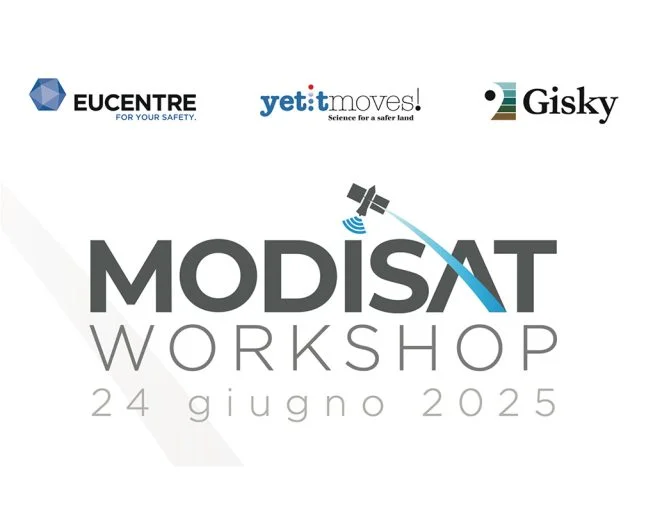On June 24th, 2025, the Eucentre Foundation will host the workshop for the presentation of the MODISAT – MOnitoraggio DInamico di ponte mediante misure di spostamento derivate da tecnologie SATellitari (MODISAT – Dynamic Bridge Monitoring Using Displacement Measurements Derived from Satellite Technologies) project, financed by the Italian Space Agency (ASI) within the I4DP Downstream and Application Services programme.
The meeting, scheduled to take place in the Multimedia Room of the Pavia headquarters from 9:00 a.m. to 2:00 p.m., will provide an up-to-date overview of the state of the art and prospects for structural monitoring of bridges and viaducts, a crucial area for ensuring public safety and sustainable mobility.
Why monitor infrastructure?
Every day, critical infrastructures such as bridges and viaducts are subjected to dynamic and cyclical loads generated by vehicular traffic, along with environmental stresses, including temperature variations, humidity, and aggressive weathering. These factors accelerate structural degradation processes such as material fatigue, corrosion of steel and deterioration of concrete and masonry.
Numerous studies have shown that ageing infrastructure, often aggravated by untimely or inadequate maintenance, can lead to a progressive decline in operating conditions and an increased risk of structural collapse. Recent events have highlighted the vulnerability of national infrastructure heritage and underscored the need for predictive monitoring strategies based on state-of-the-art technologies and preventive maintenance.
Structural monitoring is not only a technical choice but also a necessity for implementing preventive maintenance, which is oriented towards preventing failure and collapse phenomena, thereby ensuring safety and operational continuity.
The MODISAT platform
MODISAT is a web-based platform that integrates the best technology for the continuous and intelligent monitoring of critical infrastructures. Among its main functionalities:
- 3D visualisation of georeferenced BIM models with local sensors;
- Quick consultation of time series acquired from digital and analogue sensors and GNSS stations;
- Satellite radar integration for the identification of subsidence phenomena;
- Automatic operational modal analysis (OMA) for the calculation of dynamic parameters of structures;
- PONTE_APP, an integrated module for advanced numerical analyses, including seismic simulations and fragility curves;
- Dynamic Data Acquisition System (DDAS) for real-time sensor acquisition and configuration.
The official presentation video
The workshop programme to download
Date: June 24th, 2025
Location: Eucentre Foundation – Via Adolfo Ferrata, 1 – 27100 Pavia
Timetable: from 9:00 to 14:00
Modalities: in-person and on Zoom.
Participation in the course will earn 3 CFP credits to engineers.
Sign up now
Contact: info@eucentre,it
 Eucentre is a non-profit private law foundation whose mission is to conduct research and provide training and services in earthquake and safety engineering
Eucentre is a non-profit private law foundation whose mission is to conduct research and provide training and services in earthquake and safety engineering  Eucentre promotes science, research and innovation for the benefit of the community, offering targeted methodologies and concrete solutions for prevention, safety and resilience. It collaborates with institutions and companies to disseminate competencies for the common good.
Eucentre promotes science, research and innovation for the benefit of the community, offering targeted methodologies and concrete solutions for prevention, safety and resilience. It collaborates with institutions and companies to disseminate competencies for the common good. Shake-tables
Shake-tables Other test systems
Other test systems Eucentre carries out research activities in earthquake engineering and risk reduction through laboratory testing and numerical analysis, aiming to improve the seismic performance of structures and soils and to develop innovative seismic retrofitting techniques.
Eucentre carries out research activities in earthquake engineering and risk reduction through laboratory testing and numerical analysis, aiming to improve the seismic performance of structures and soils and to develop innovative seismic retrofitting techniques. The Foundation promotes diverse and high-quality training activities aimed at academic and professional contexts, with constantly updated and innovative programs and initiatives designed to meet the evolving needs of the sector and society
The Foundation promotes diverse and high-quality training activities aimed at academic and professional contexts, with constantly updated and innovative programs and initiatives designed to meet the evolving needs of the sector and society  Eucentre ensures communication aimed at informing institutions, professionals, and citizens about ongoing activities and projects, with the goal of disseminating useful and accessible content and knowledge. It contributes to promoting a shared and informed culture of prevention and resilience.
Eucentre ensures communication aimed at informing institutions, professionals, and citizens about ongoing activities and projects, with the goal of disseminating useful and accessible content and knowledge. It contributes to promoting a shared and informed culture of prevention and resilience.
